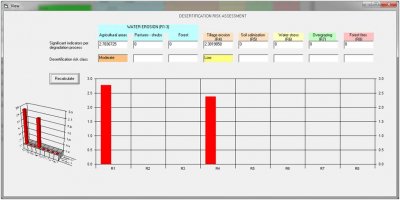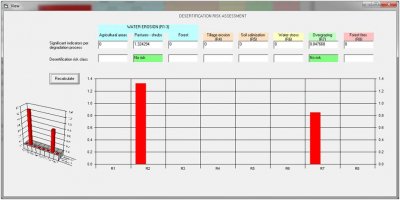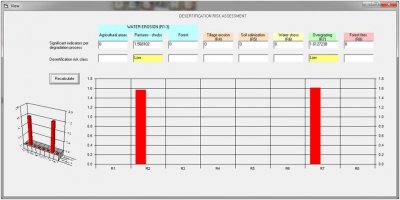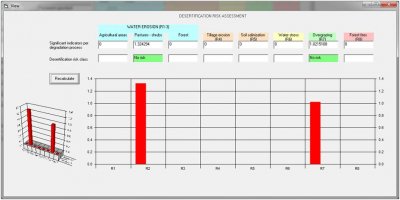| Evaluating the desertification risk assessment tool with local experimental results |
 |
|
Author: Victor Jetten
Introduction
Olive groves are an important form of land use in the area, but have various degrees of due to the different land management practices. Farmers perceive an herb cover as a competition for water for the Olive trees and keep the field clean and bare below the trees. A minimum tillage experiment with and without herbicides was carried out to see if it is possible to maintain a soil cover, restore the natural soil structure, promote infiltration and reduce runoff and helps in minimizing soil losses. Overgrazing on the shallow stony soil decreases cover and destroys soil structure, and therefore promotes runoff and erosion. A grazing control experiment was done in this area.
The Olive area is moderately sloping land (up to 17%) with relatively deep soil (55-65cm). The overgrazed area has very shallow soils with frequent outcrops.
Desertification indices
Olives and minimum tillage: the overall unmitigated risk is moderate for water and tillage erosion on sloping Olive fields without soil cover and erosion control measures, and tillage operation to keep the area between the trees bare. Minimum tillage decreases the water erosion slightly and tillage erosion more (to low risk). The main factor here is setting the tillage operations from ploughing to none. Setting minimum tillage or no-tillage has no effect.
Grazing lands seem to have a low risk for water erosion and low risk for overgrazing. Increasing the vegetation cover by fencing the rangeland will correctly decrease both to a no risk level, but the change is not very large.
Conclusions
The assessment tool exhibits strange behavior that the setting of minimum tillage or no tillage has no effect on water erosion, but setting tillage operations form ploughing to none has.
|
Study sites
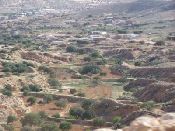
Acknowledgement
The DESIRE project was
|
DESIRE brought together the expertise of
26 international research institutes
and non-governmental organisations.
This website does not necessarily
represent the opinion of the
European Commission. The European
Commission is not responsible for
any use that might be made of the
information contained herein. 

